Photos: Kip Miller
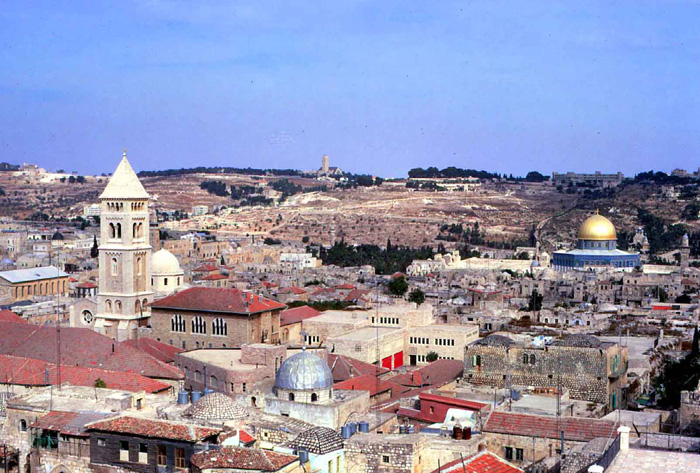
The Old City of Jerusalem as viewed from Hebron Road.
It's the previous evening. Our Israeli guide, Avital, winds up Hebron
Road and deposits my husband and me and our friend Elinor at the Mt. Zion
Hotel. Commanding magnificent views of the old city and beyond, the 1880
property, once an eye hospital, has undergone many permutations and now
encompasses six floors that descend the hillside to a large swimming pool.
We enter the airy lobby and are quite taken by its views and Moroccan-inspired
décor. In the soft evening light, we set out to explore the surrounding
area. The views of the Hinnom Valley and the Mount of Olives are quite
dramatic and we can almost make out Mt. Scopus in the distance. Nearby
historic sites include the Gardens of Gethsemane, Dormition Abbey, and
what is traditionally regarded as King's David's tomb. Not far down the
hill is Oskar Schindler's grave. The German industrialist, regarded as
the world's most righteous among gentiles and forever memorialized by
Spielberg's film, specifically asked to be buried here. We pause outside
a large cinematheque where several dozen high-spirited youths have gathered,
chattering non-stop over their ice cream cones. Across the road is the
much-visited Menachim Begin Center, dedicated to the life and contributions
of Israel's sixth prime minister. A former commander of the violent, paramilitary
right wing organization known as Irgun which finally swore its allegiance
to the IDF, Begin signed a peace treaty with Anwar Sadat of Egypt in 1979.
"Wow," says Elinor. "Every inch of land here has enormous
significance!"
Avital has
the day off, so the three of us start out mid-morning to explore the Old
City on our own, heading downhill to Jaffa Gate. Jerusalem's limestone
walls date from the Ottoman Era and are renowned for their golden color
that has mellowed over the centuries. We make our way into the bustling
Armenian Quarter, crowded with many wonderful shops. Straight ahead an
antique store lures us in with its window display of color maps. Its affable
proprietor sizes us up instantly and heads to a back room, returning minutes
later with an assortment of rare 19th century maps depicting the twelve
tribes of Israel. They are all exceptional and we quickly choose one to
take home. The shop is abuzz with international customers. I listen in
amazement as the owner switches from English to French to Arabic, Italian,
German and even Swedish. "Have you noticed how adept many Arabs are
with languages?" I remark to my husband. "Indeed, they put us
Americans to shame," he concurs. A good portent for more shopping
ahead, I decide.
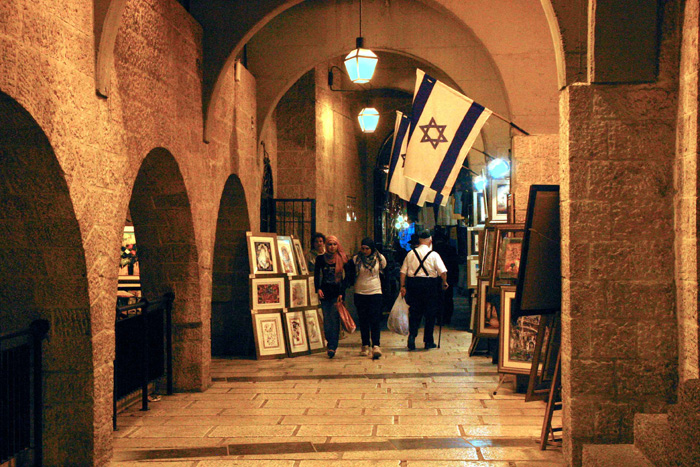
Off the ancient Roman Cardo, shops are filled with art, jewelry and Judaica.
We turn right toward the Jewish Quarter, walking on the former Roman Cardo,
built after the final destruction of Jerusalem in 70 CE when the city
was renamed Aelia Capitolina by Emperor Hadrian. There is restoration
work going on in all directions. Old Byzantine Corinthian columns are
left in situ alongside new shops brimming with tourist merchandise. We
pause to admire four Sephardic synagogues that have been meticulously
restored. Dating from the Muslim Period, they display an amazing stash
of ritual objects rescued from Italy during the Holocaust. The twice-destroyed
Hurva Synagogue, traditionally regarded the most beautiful in all of Israel,
has been rebuilt in its orginal style, affording breathtaking views of
the Old City and beyond from atop its dome. The Kotel--the Western Wall
of Herod's Temple--will be the highlight of our tour with Avital tomorrow.
At a family-run
Greek restaurant near the historic Church of St. John the Baptist, we
dive into a salad topped with imported Metsovo feta and a side of crispy
zucchini fritters. The Old City is full of culinary delights, I decide,
as we continue our foray into the Arab Quarter. Time has stood still among
the serpentine lanes of this large, rambling sector thronging with shoppers.
Several robed women, their hair covered with scarves, are sitting right
on the stepped pavement, selling mounds of greens grown in their home
villages. An aromatic Arab pastry shop straight ahead beckons with round
slabs of knafeh, a confection that originated in Nablus on the West Bank
in the 10th century. We stop to sample it. Made with thick filo dough
layered with ricotta cheese and bathed in syrup with a sprinkling of chopped
pistachios, it is a sweet that rivals the best the world has to offer.
"Right now I can't imagine anything better than this," my husband
sighs as he devours his portion. We continue toward Damascus Gate, the
largest and most elaborate entrance to the Old City. Today the gate area
has been transformed to an open-air market, crowded with customers haggling
spiritedly at improvised shoe and clothing stalls.
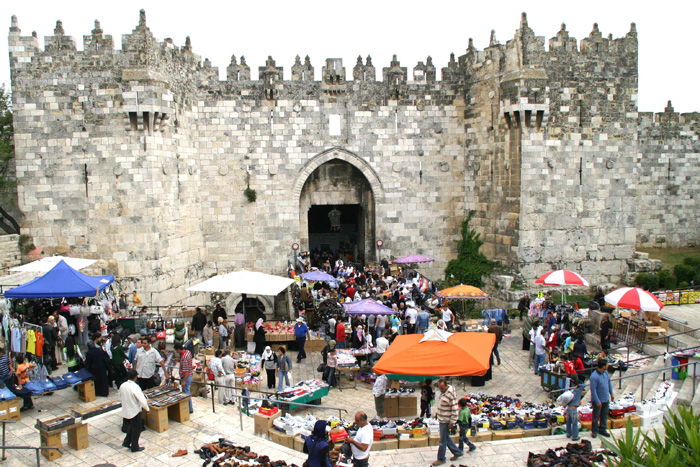
The Old City's largest portal, Damascus Gate, is transformed into an open-air market.
Ten minutes from Jaffa Gate, just outside the city walls, is Jerusalem's
historic King David Hotel. It was the brainchild of Ezra Mosseri, a wealthy
Egyptian-Jewish banker who wanted to build a world-class property that
would be adjacent to the Old City and also blend in with the local architecture.
It remains an elegant hostelry to this very day, still rivaling several
high-end properties that have been built in the last couple of decades.
Constructed of local stone, the King David is "the place" that
leaders and celebrities from around the globe always flock to. A marble
stripe on the ground floor is inscribed with reproduced signatures of
all the dignitaries who have stayed at the property--from Anwar Sadat
and and Haile Selassie to Queen Elizabeth, Richard Nixon, Barack Obama
and Hillary Clinton. We survey the list as we head toward a magnificent
terrace and pool overlooking Jerusalem's burnished stones. A bellhop notices
our interest, commenting: "It was here that King Hussein signed the
peace treaty between Jordan and Israel. Many very important meetings have
taken place at the hotel over the years."
Not far from the hotel is Jerusalem's iconic Montefiore Windmill. Dating from the Ottoman era, the mill was financed by British philanthropist Moses Montefiore who wanted to create a means for local Jewish settlers to become more self-sufficient. "All the mechanical parts for the mill were shipped from England to Jaffa and then arrived in Jerusalem transported by a team of camels," my husband chuckles, having read extensively about the structure. We can almost envision the scene. "By the way, the mill was barely put into use," he adds. "Its mechanical components were designed for English wheat and did not process local wheat efficiently. But it immediately added a lot of character to the Yemin Moshe neighborhood here. These days the windmill serves as a venue for art exhibitions and even has a nightly sound and light show." I remember reading somewhere that the government has future plans to redo all the mechanics to make it function properly, and when that happens, it will be the sole working windmill in all of Israel!
Facing the
King David Hotel is the imposing Jerusalem YMCA, the creation of Arthur
Loomis Harmon, an American architect who also designed the Empire State
Building. The structure is fronted by a dozen cypress trees meant to represent
the 12 tribes of Israel. Forty columns in the courtyard allude to the
40 years the Hebrews spent wandering in the desert in the Exodus story
as well as the temptations foisted upon Jesus by the devil during his
ramblings in the Judean desert. The architecture itself is an altruistic
homage to Judaism, Christianity and Islam and the structure is an amalgamation
of styles meant to be all-inclusive. "Upon the completion of the
YMCA, it was hoped that it would be a place of peace where political and
religious jealousies could be put aside and international unity fostered.
Too bad this sentiment never materialized," sighs Elinor as we head
into the dining room. The menu has an institutional quality, but the dining
room is one of the few places open for meals on Saturdays. "You should
climb up the 192 steps to the top of the tower," our waiter suggests.
"The view is incredible and on a clear day you can see the mountains
in Jordan!"

On the Temple Mount, the Dome of the Rock is the world's oldest extant Islamic monument.
In the cool of morning we start out with Avital toward Dung Gate and Jerusalem's holiest sites. At the edge of the western wall, a ramp leads into the Temple Mount, also known as Haram al-Sharif. "This was the location of Solomon's Temple which contained the Ark of the Covenant," says Avital, "but, of course, you know that." We slowly approach the magnificent, golden-domed Qubbat al'Sakhra, a shrine which contains Abraham's Rock, atop which he was willing to sacrifice his son, Isaac, until God intervened. The rock also marks the spot where Muhammad supposedly ascended to heaven on his famous night journey. The shrine is magnificent, with remnants of exquisite tile work from the era of Suleiman the Magnificent. I am disappointed, although not surprised, that we are not permitted to enter. The golden dome glitters in the bright sun, its current state of perfection due to the generosity of King Hussein who sold several London properties to pay for additional gold leaf needed for restoration. We turn in the direction of the lead-domed Al-Aqsa mosque, also known as Qibly Masjid, meaning furthest mosque. It is Jerusalem's most important mosque and the site of frequent conflagrations. "Today the Temple Mount is peaceful," says Avital. "But things have not been the same since the day Ariel Sharon's visit instigated a violent clash that led to the Al-Aqsa Intifada!"
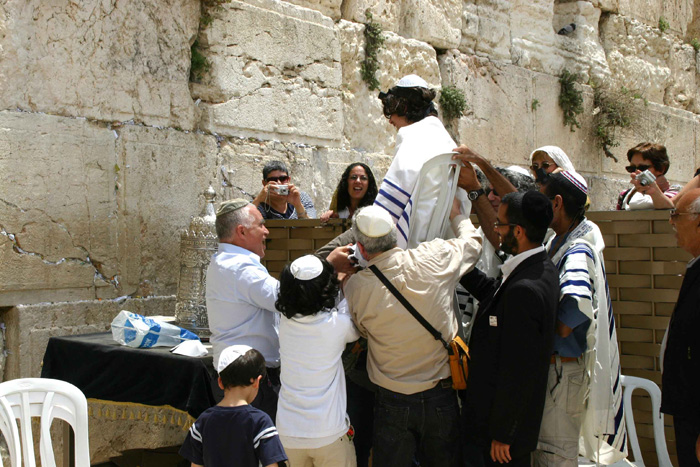
The sole remnant of Herod's Temple, the Western Wall is the site of Bar Mitzvah celebrations.
We slowly approach the sacred Western Wall, the only remaining part of the Second Temple, to find it churning with activity. About a dozen Hassidic worshippers are bobbing at the wall's edge reciting devotional prayers, their heads draped in prayer shawls and phylacteries. Several women are praying at a separate area specifically designated for them. A lively Bar Mitzvah celebration has burst into full swing at another section of the wall as a beaming youth is lifted into the air in a white plastic chair by his proud family members. "On any given day, you will see several ceremonies here," Avital comments. "People come from all the way from America and Europe to celebrate bar mitzvahs at the wall because here the ritual has even greater significance." I approach the women's section of the wall, recalling my first visit in 1969 when my eyes welled with tears as I touched the ancient stones.
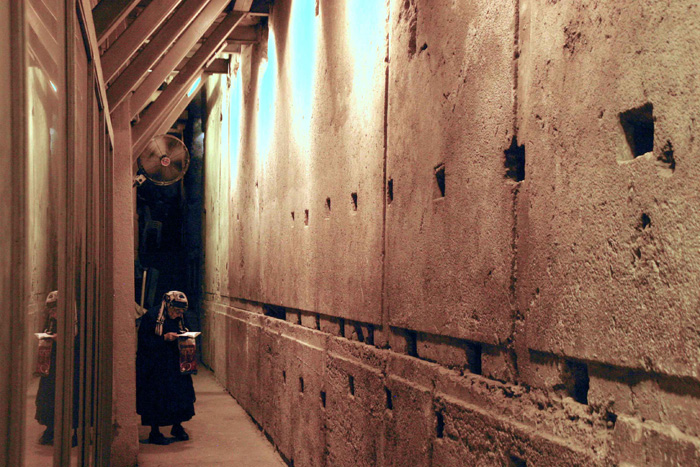
The tunnel tour reveals pristine Herodian stones not far from where Solomon's Temple once stood.
"Now we are going to take the tunnel tour which descends below the Temple Mount and reveals portions of the original Herodian wall in surprisingly pristine condition," Avital explains. "There is no other spot on earth that is more holy to Jews." I am pleased to see that our tour group is being led by a docent who is a fount of information. Standing next to a platform topped with a scale model of Herod's Temple, he points out all the relevant areas and asks us questions, initiating a spirited discussion. We arrive at a section of the wall which is nearest to the spot to where Solomon's Temple once stood, shielding the precious Ark. Here the wall's original Herodian stones are in amazingly pristine condition. Three orthodox women, their hair covered, are bobbing and reciting prayers. It is a very moving scene. "They carted away tons of earth from here when they excavated the tunnel," our docent reveals. "Volunteers and archaeologists have been sifting through the soil continuously for several years," he adds. "All that diligence has paid off. A handful of remnants from Solomon's temple have been identified by radiocarbon dating."
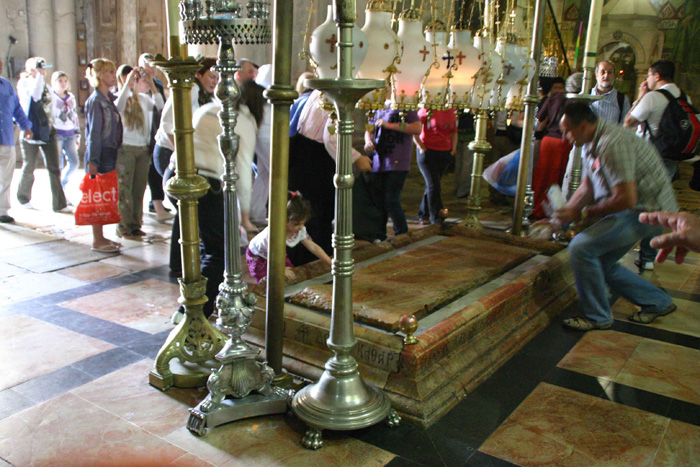
The tomb of Christ in the Church of the Holy Sepulchre is Christendom's holiest site.
The end of the tunnel takes us to a staircase that heads into the Christian Quarter. "We are going to walk on the Via Dolorosa and stop by some of the Stations of the Cross," Avital announces. Jerusalem's significance for the three Abrahamic faiths is overwhelming. In this quarter, the crowd is a mix of pilgrims and ordinary tourists from all over the world. We pause by one of the 14 Stations of the Cross and then head toward the Church of the Holy Sepulchre, Israel's most visited site. Rebuilt and repaired several times, it first emerged in the fourth century after Emperor Constantine's conversion to Christianity. He immediately sent his mother, Empress Helena, on a mission to the Holy Land to locate Golgotha, the exact spot where Christ was crucified and buried. Helena found it and supposedly even brought chunks of the original cross back to Rome. A church was erected at Golgotha atop the site of a pagan temple. Rebuilt and expanded numerous times over the centuries, today's Holy Sepulchre is jointly administered by three denominations: Greek Orthodox, Roman Catholic and Armenian Apostolic. The size and complexity of the church is somewhat bewildering. We witness a solemn procession of prelates bearing incense making its way through the crowd. A slew of worshippers encircle the marbled Aedicule, the final station of the cross. Some are prostrated on the floor, a few are weeping. The Aedicule is managed by the Greek Patriarchate and is believed to be the exact location of the tomb of Jesus. It is Christendom's most venerated site. Avital leads us under beautiful domes and past multiple gilded chapels dedicated to Helena, Adam and various crusader kings as we slowly make our way toward the exit. "Tomorrow we will start out early on our excursion to Masada and Qumran," he reminds us. Be ready by eight AM."
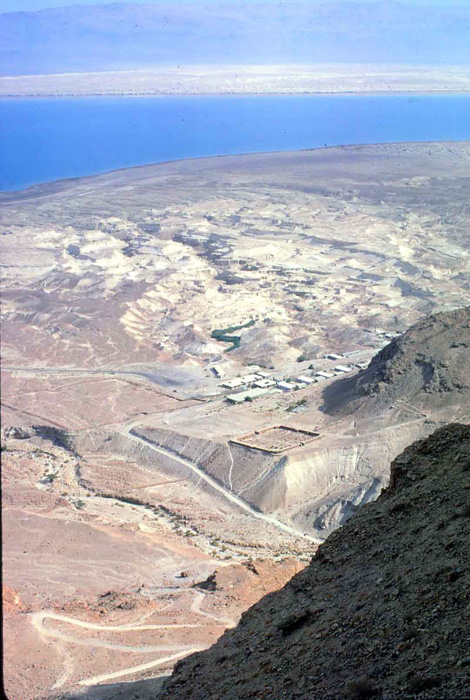
Masada overlooks the Dead Sea and remnants of Roman camps that besieged it.
We wind out of Jerusalem into the stark Judean wilderness. Not far from the Dead Sea, the lowest spot on earth, rises a massive plateau crowned with the remains of the settlement of Masada. Nearly 450 meters above the desert floor, the site provided a last haven for Israelite zealots during their final revolt against Rome in 73-74 CE. Lower down at 56 meters, on the plateau's northern edge, are remnants of one of Herod's many palace retreats, a tour de force of engineering complete with cisterns to collect rainwater and commanding magnificent views of the desert below. In 1969 my husband and our cousin Giora ascended the traditional 700-step switchback path to the top, an arduous climb to say the least. Today Masada is Israel's most visited national park and a UNESCO World Heritage Site that is easily reached by a modern cable car. It is enormously popular with both young and old and especially with members of the IDF. We arrive at the Visitor's Center and watch a film that relates the story of the zealots' last-stand against the Roman army. "There are plans underway to create a state-of-the-art sound and light show that can be viewed from below," says Avital. "I am sure it will be fantastic," I reply as we trail Avital on a tour of the site. He pauses by a sign explaining the final act of the zealots. "Tragically, when it became inevitable that the Romans would prevail, the zealots resolved not to be taken alive and forced into a life of slavery. They drew lots to determine who would kill whom, with the final survivor falling on his own sword. When the legion of Flavius Silva reached the summit, they found 970 dead bodies. This final dramatic moment of Masada happened on the eve of Passover," Avital waves his hand for emphasis!
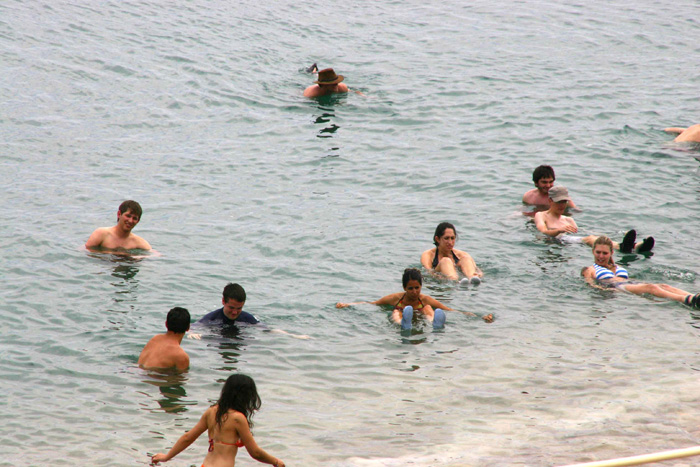
The extreme salinity of the Dead Sea enables bathers to float on its surface.
The Dead Sea is not only the earth's lowest spot, it is also its saltiest body of water. We approach one of several beach areas popular with young and old. Even from afar I can see that the high salt content of the water allows bathers to "sit on the surface of the water." Of course we have to check it out for ourselves. Immediately, my blistered big toe begins to sting mightily. "Ouch," I shout for all to hear. I had forgotten that any wound on one's body, not matter how small, would react to the salt immediately. But I brave it for a few minutes more to gain the sensation of bobbing on the surface of the sea. We continue to Ein Gedi National Park. A desert oasis that is renowned for its diverse plant life and waterfalls, the park is located at the terminus of a wadi that ends in a series of shallow pools. The oasis is also a haven for wildlife, most notably for a large herd of Nubian Ibex with their characteristic curled horns. "There must be other animals living in this area," my husband remarks. "Yes, and even more than you would expect," smiles Avital. "There are foxes, wolves and vultures with huge wing spans to name just a few! But our time is going fast, let's continue to Qumran."
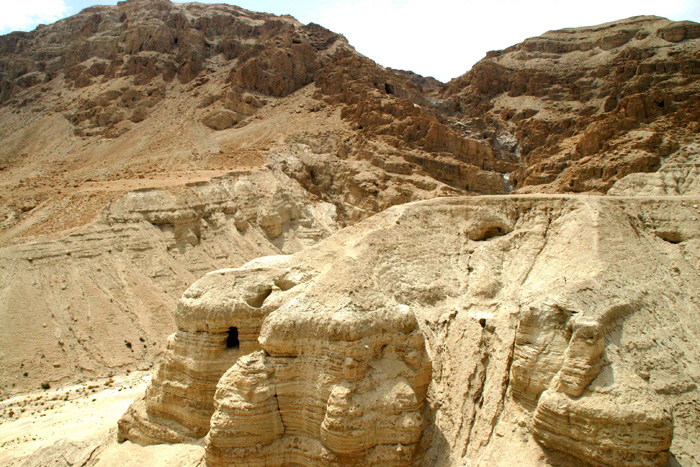
Nearly 900 biblical scrolls have been discovered in the caves of Qumran.
The parking lot at Qumran is located near the northwest shore of the Dead
Sea. The site is operated by Israel's Nature and Parks Authority even
though it is officially in Palestinian territory. Qumran gained international
notoriety when a young Bedouin shepherd entered a long-forgotten cave,
having thrown a stone after a goat that had wandered inside. He heard
a shattering sound and came upon a tall clay pot shielding a hoard of
ancient scrolls. The discovery convulsed the world of bible study. The
hoard quickly became known as the Dead Sea Scrolls, carefully preserved,
analyzed and then displayed at Jerusalem's Shrine of the Book Museum.
Eventually, some 900 scrolls were discovered in eleven additional caves.
Most were mere fragments, like pieces of a jigsaw puzzle. But a few were
more intact. To this very day the origin of the scrolls has yet to be
fully ascertained. Were they written in Jerusalem and hidden away in desert
caves for safekeeping during the uprising against the Romans? Or were
they the original work of the Essenes, an ascetic cult that lived near
the caves in a remote outpost, operating under strict communal practices,
and whose beliefs may have made an impression on Jesus during his desert
wanderings? "There is a lot of speculation when it comes to the Essenes,"
Avital explains. "Some scholars say they represent the 'border line'
between Judaism and early Christianity. Others believe that they are simply
the historical fabrication of Josephus and Pliny. Was Jesus trained by
the Essenes? We can only speculate. The cult had its own esoteric rules
for daily life." We watch a visitor's film that explains the rituals
and activities of the Essenes, shows their dining hall, their kitchen
and nearby boneyard where no porcine bones were found, their ten ritual
baths and a very special writing room with inkwells. "The Dead Sea
Scrolls have become my special obsession," my husband admits to Avital
and Elinor. "It's a thrill to actually see where it all began!"
We have two free days to explore Jerusalem on our own before leaving on a journey to northern Israel to be followed by four days in Jordan. "You can get to Yad Vashem by bus, but a taxi would be quicker," they tell us at the desk. One pulls up in front of the Mt. Zion in no time. The Iraqi-born driver speaks enough English to make himself understood and heads to the hills of West Jerusalem through Rehavia. My parents lived not far from here in Nachlaot after their kibbutz life. If only these old stones could talk, I think, wishing I knew more about their time here. In 1969 we toured the original Yad Vashem Memorial Museum, dedicated to the victims of the holocaust. I remember walking through The Avenue of the Righteous among Gentiles honoring the brave souls who risked their lives to rescue Jews. Today we will be visiting the award-winning new museum, designed by the renowned Israeli architect Moshe Safdie. I am especially excited to see his creation since he also designed the Skirball Cultural Center in LA where I am a docent.
Yad Vashem sits on the slopes of the Mount of Remembrance, cantilevered on two sides. It opened in 2005 and has since attracted millions of visitors. Shaped like a prism penetrating the mountain, its bold architecture sets the stage for a harrowing visitor experience inside. A range of multimedia exhibits includes films, photos and many personal objects that were found in the ghettos and concentration camps. Photographs are only permitted by special application and we wander through each section in respectful silence. There are nine interactive galleries that convey the unspeakable horrors of the holocaust via films, photos, documents, and items left behind in the camps. As we near the exit, a soundtrack breaks into the Hatikvah. All the emotion that I had managed to suppress as I walked past each gut-wrenching segment is suddenly released, and a non-stop stream of tears trails down my face. I look at the faces of some other visitors. All are equally moved. We continue to a The Hall of Remembrance, a cone-shaped memorial lined with hundreds of photos of actual holocaust victims. It is positioned atop a lower cone dug out of the rock base and filled with water that reflects their faces. The entire Yad Vashem campus is enormous, comprising a wide range of research and visitor facilities. Our time here has been emotionally draining and we gratefully pile into a taxi to return to the hotel for naps.
By early
evening we are starved. The desk recommends Eucalyptus, a restaurant on
Felt Alley near Zion Gate that is considered one of Jerusalem's best.
It is the creation of celebrity chef Moshe Basson, the winner of several
food competitions who is renowned for creative cuisine based on local
and regional produce as well as unusual fish and meat dishes. He is also
a food folklorist known to glean the hills around Jerusalem for nettles
and wild greens. Son Ronny, also a chef, greets us warmly, handing us
their extensive menu. It's nearly impossible to choose, but we zero in
on a buttery barramundi fish served with smoked green risotto and salmon
sashimi with wasabi and shaved nettles. The restaurant is also famous
for its exquisite ceviche and fish shawarma with fire-roasted eggplant.
"This is a meal for the ages," Elinor exults. "We have
nothing quite like this in England and in my opinion chef Basson even
outranks Yottam Ottolenghi!" As we head uphill to the hotel, I suddenly
remember that on the occasion of Israel's 50th anniversary celebration
in Washington, D.C., Basson was one of several Israeli chefs invited to
cook at a gala at the Kennedy Center. We continue to our hotel in a food
coma, but with huge smiles on our faces.
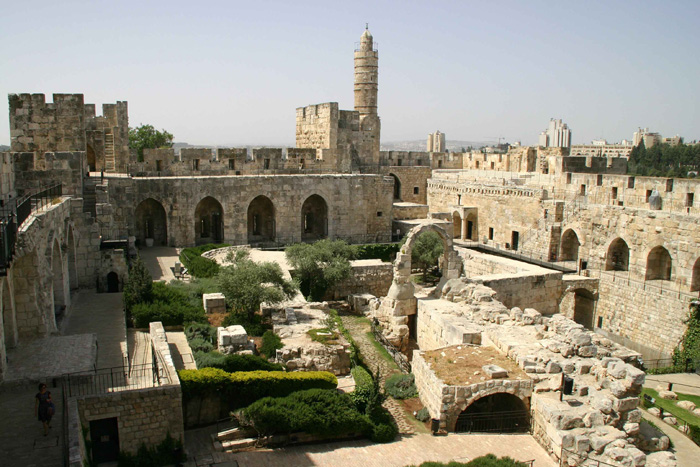
The Tower of David, a Crusader complex, houses a museum dedicated to the history of Jerusalem.
It is decidedly hotter the next morning. With water bottles at hand, we
start out early toward the Tower of David Citadel that houses a museum
dedicated to the history of Jerusalem. "The name is misleading,"
says our docent, a former New Jersey resident who has made Jerusalem her
permanent home. "This fortress actually dates from the Crusader era."
She leads us inside where a number of imaginative tableaux showcase the
history of the city over the centuries, from its beginning as a Canaanite
settlement all the way to the modern era. We pause by a scene depicting
the Assyrian siege of Jerusalem, when King Sennarcherib attacked the city,
but failed to capture it. Each and every tableau is a creative visualization
of important moments in the city's convoluted history.
After the destruction of Jerusalem in 70 AD, the area below its southern wall was covered by an avalanche of stones. Today the site is the location for Jerusalem's official Archaeological Headquarters, The Davidson Center. The area is in continuous flux as more excavations take place and new finds are identified. Hundreds of thousands of cubic meters of earth have been removed to date and a few of its numerous findings even date back to Solomon's time. We enter the museum area and join a group of visitors, paying rapt attention to a guide who providing an introduction to the site. A group of noisy teenagers completely drown out his voice. "Sheket Bvakasha, (quiet please)," I admonish them, totally surprised to have erupted in the Hebrew of my childhood. "I think your Hebrew is locked up somewhere in your brain," my husband comments. "Perhaps a hypnotist could help release it," he posits.
Many days
later, after returning from Jordan, our exploration of Jerusalem begins
anew. It's delightful to stroll through the recently opened Mamilla Mall,
another of Safdie's creations, with upscale boutiques and cafes lining
its stone walkway just northwest of Jaffa Gate. Safdie brilliantly blended
a few original buildings into his design and used masonry block stones
for the project, creating a timeless quality that ties into the architecture
of the Old City. Not far away, on the Ben Yehuda pedestrian mall, we sample
one of Jerusalem's most popular falafel joints, Noshiko. It does not disappoint.
The area is packed with tourists and a couple of dozen residents from
the ultra-orthodox Mea She'Arim neighborhood who come to shop at Ben Yehuda's
numerous Judaica shops. A short taxi ride away, Mahane Yehuda is Jerusalem's
historic food market also known as "The Shuk" and a feast for
the senses. It's especially fun to watch well-practiced matrons haggle
non-stop with the merchants, a skill they been honing for decades. There
area also plenty of copycat tourists who bravely try their hand at bartering,
but with far less success.
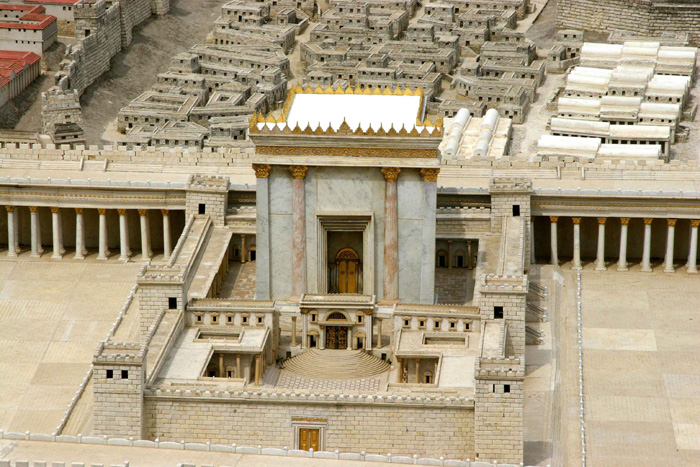
An enormous scale model of ancient Jerusalem is the showpiece of The Israel Museum.
Another taxi drops us off at The Israel Museum, renowned for impressive 2,000-square meter model of Jerusalem as it existed during the Second Temple Period. Built on a scale of one to fifty, it utilizes the same stone and marble of the original. "Amazing," says my husband. "How did they do it?" The model is the creation of Michael Avi-Yonah, an expert on the ancient city who gleaned information for its design from the writings of Josephus and from the Mishnah, a collection of Jewish oral traditions culled by learned rabbis. At the Museum's world famous Shrine of the Book, we are regaled with close-ups of many of the parchments found at Qumran. Having been at the source, all three of us are super excited to see the scrolls. Alas, the main museum that houses Israel's archaeological horde is closed for renovations. "What a bummer," I gripe. I had been so looking forward to seeing its treasures, all the more so because I have lead archaeology tours for Los Angeles elementary school students who are bussed to the Skirball on special outings.
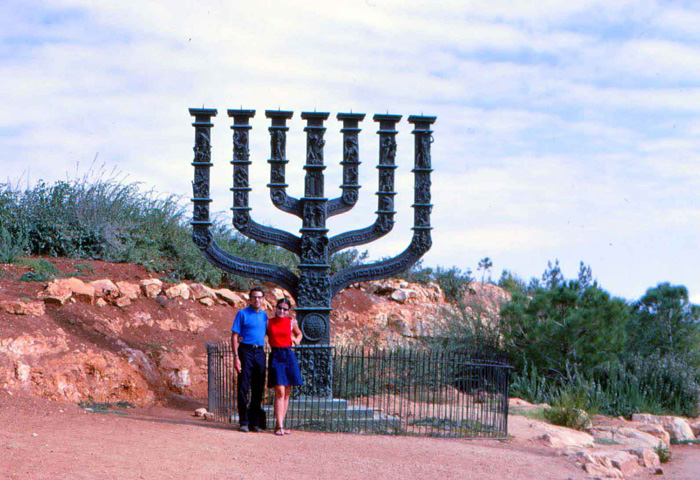
On our first visit in 1969, we posed by the Knesset's bronze menorah.
Our final day in Jerusalem is a Saturday, and taxis and busses are not
operating. We head out on a long serpentine walk toward Givat Ram in West
Jerusalem and the city's Parliament building known as "The Knesset."
Being Shabbat, it is closed to visitors. However, its iconic landmark,
an enormous bronze menorah located at the edge of Wohl Rose Park, can
be seen. Positioned opposite the building, it is the work of Benno Elkan,
a Jewish sculptor who escaped from Nazi Germany to Britain before the
onset of World War II. The menorah was a special gift from the British
Parliament in 1956 to mark the eighth anniversary of Israel's founding.
"Each of the menorah's branches depicts many important moments in
the history of the Jewish people, such as receiving the Ten Commandments
and the Warsaw uprising," I explain. "The Menorah sure looks
like the one that stood inside the Temple in Jerusalem. The center candle
must be the most important," my husband observes. "You are right,"
I reply. "That candle is inscribed with the 'Shema--Hear O Israel
Prayer' that conveys Judaism's monotheistic essence."
On our seemingly endless walk back to the Old City, a solitary taxi operated by an Arab in search of customers stops to ask us if we need a ride. "You bet," an exhausted Elinor sighs happily. He drops us off at the YMCA per our request because we know it is open for meals on Saturday. The familiar menu includes a variety of fresh salads and their own house-made bread. Good enough, we decide, grateful that we can grab a bite in mid-afternoon while the rest of the city is still in Sabbath mode.
"Our time in Israel sure has gone by in a flash," Elinor sighs wistfully. A sherut taxi, ordered by the desk and bound for Ben Gurion Airport, pulls up in front of the hotel in plenty of time to make our late afternoon flights. Somehow, we are the only customers today. Our driver is super friendly and knowledgeable, sharing little-known factoids about the government, the Intifada, and the successes of Israel's high tech industry as he speeds along the highway. At the airport, we take our place behind a long line of passengers going through security check. "I see that you are a Sabra," says the youthful inspector. "Did you enjoy your visit?" I nod enthusiastically. "Did anyone give you any packages to take on the plane? "Did you visit any Arab villages on the West Bank?" "Of course not," I reply. "OK, we will now x-ray your suitcase," he continues. "What is this round object inside?" the x-ray attendant asks. I explain that it is a bubble-wrapped ceramic platter purchased in the Armenian Quarter. The same routine is repeated for Elinor and my husband. Satisfied that we are not shielding any hidden bombs or weapons, the inspector breaks into a smile: "You may now proceed. After you check in your luggage, keep an eye on your handbag and any items you may buy in our gift shops. We are taking extra precautions these days."
At the airport's well-stocked music shop, we select several CDs by Ofra Haza and by Israel's first lady of song and poetry, Naomi Shemer. The purchase is a perfect bookend to the time spent in my birth city, I conclude, since our visit began with the music of "Jerusalem of Gold!"
